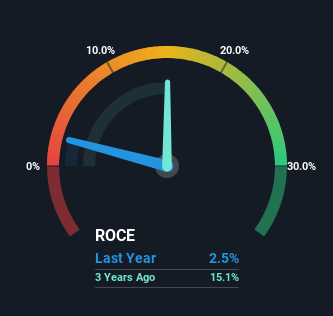Investors Could Be Concerned With Gale Pacific's (ASX:GAP) Returns On Capital
What financial metrics can indicate to us that a company is maturing or even in decline? Typically, we'll see the trend of both return on capital employed (ROCE) declining and this usually coincides with a decreasing amount of capital employed. This indicates the company is producing less profit from its investments and its total assets are decreasing. Having said that, after a brief look, Gale Pacific (ASX:GAP) we aren't filled with optimism, but let's investigate further.
Return On Capital Employed (ROCE): What Is It?
For those that aren't sure what ROCE is, it measures the amount of pre-tax profits a company can generate from the capital employed in its business. To calculate this metric for Gale Pacific, this is the formula:
Return on Capital Employed = Earnings Before Interest and Tax (EBIT) ÷ (Total Assets - Current Liabilities)
0.025 = AU$2.8m ÷ (AU$188m - AU$75m) (Based on the trailing twelve months to December 2023).
So, Gale Pacific has an ROCE of 2.5%. In absolute terms, that's a low return and it also under-performs the Consumer Durables industry average of 16%.
View our latest analysis for Gale Pacific
While the past is not representative of the future, it can be helpful to know how a company has performed historically, which is why we have this chart above. If you want to delve into the historical earnings , check out these free graphs detailing revenue and cash flow performance of Gale Pacific.
What Does the ROCE Trend For Gale Pacific Tell Us?
In terms of Gale Pacific's historical ROCE movements, the trend doesn't inspire confidence. About five years ago, returns on capital were 13%, however they're now substantially lower than that as we saw above. Meanwhile, capital employed in the business has stayed roughly the flat over the period. Companies that exhibit these attributes tend to not be shrinking, but they can be mature and facing pressure on their margins from competition. So because these trends aren't typically conducive to creating a multi-bagger, we wouldn't hold our breath on Gale Pacific becoming one if things continue as they have.
On a side note, Gale Pacific's current liabilities are still rather high at 40% of total assets. This effectively means that suppliers (or short-term creditors) are funding a large portion of the business, so just be aware that this can introduce some elements of risk. Ideally we'd like to see this reduce as that would mean fewer obligations bearing risks.
The Bottom Line
In summary, it's unfortunate that Gale Pacific is generating lower returns from the same amount of capital. Investors haven't taken kindly to these developments, since the stock has declined 37% from where it was five years ago. Unless there is a shift to a more positive trajectory in these metrics, we would look elsewhere.
Gale Pacific does have some risks, we noticed 3 warning signs (and 1 which can't be ignored) we think you should know about.
While Gale Pacific isn't earning the highest return, check out this free list of companies that are earning high returns on equity with solid balance sheets.
Have feedback on this article? Concerned about the content? Get in touch with us directly. Alternatively, email editorial-team (at) simplywallst.com.
This article by Simply Wall St is general in nature. We provide commentary based on historical data and analyst forecasts only using an unbiased methodology and our articles are not intended to be financial advice. It does not constitute a recommendation to buy or sell any stock, and does not take account of your objectives, or your financial situation. We aim to bring you long-term focused analysis driven by fundamental data. Note that our analysis may not factor in the latest price-sensitive company announcements or qualitative material. Simply Wall St has no position in any stocks mentioned.

 Yahoo Finance
Yahoo Finance 
